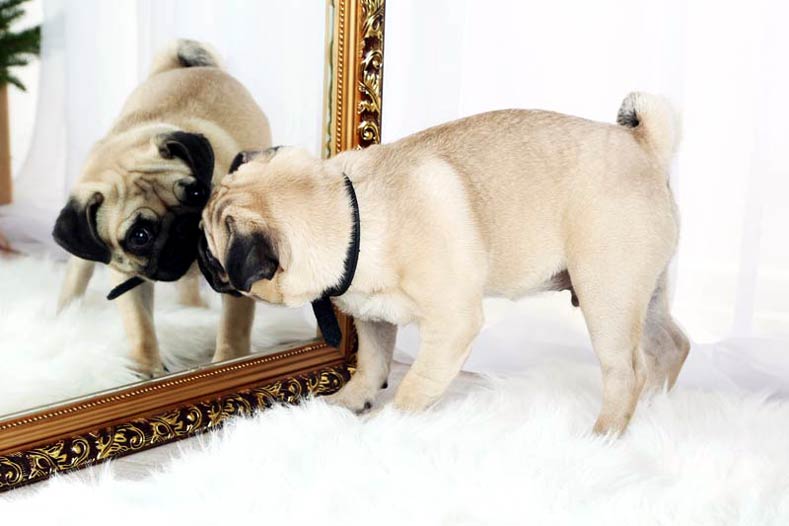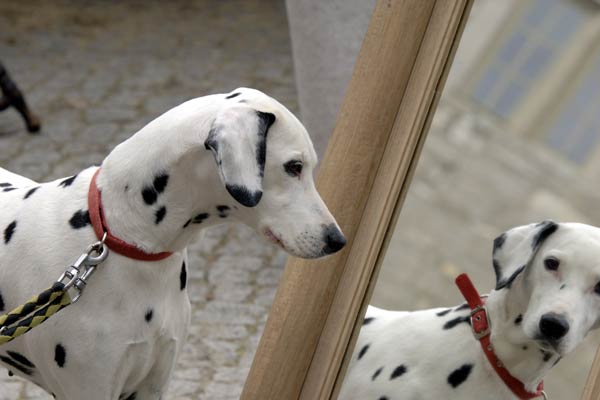
Self-awareness is the ability to think about yourself as an individual and to realize that you are separate from others around you – to have a sense of self. It’s considered a prerequisite to understanding that others might have different feelings or thoughts than you do. This is a key part of being human, and to some scientists, it’s a debatable dividing line between people and animals.
Because you can’t ask them what they think about, the classic way to study self-awareness in animals is with the mirror test developed by Gordon Gallup, Jr. in 1970. To conduct the test, an animal’s body is secretly marked, for example by placing odorless red dye on the face, and then the animal is given access to a mirror. If he understands he is looking at himself and not another animal, he might touch the mark while looking in the mirror or turn his body to better see the mark’s reflection. That would indicate self-recognition, which in turn hints at self-awareness.
Mirror self-recognition may seem obvious to people, but it requires a certain cognitive sophistication. In fact, human babies don’t understand mirrors until they are 18-to-24 months old. Over the years, only a few animal species have passed the test. And dogs are not one of them. Your dog’s early encounters with a mirror may have made him fearful or curious about the other dog in the room. This lack of understanding seems surprising, considering the other complex mental and social skills dogs have been shown to possess.
But there might be a simple explanation. Humans are visual creatures; we experience the world primarily through sight. Dogs do not. A dog’s sense of smell is his main gateway to the world. This led Roberto Cazzolla Gatti, a researcher at Tomsk State University in Russia, to hypothesize that scent may be the window to self-recognition and possibly self-awareness in dogs. He developed the sniff test of self-recognition and found that dogs seemed to recognize whether an odor was their own.
Alexandra Horowitz, a researcher from Barnard College, recently published her own experiment in the journal Behavioural Processes. She studied dogs, using Gatti’s sniff test, in two different experiments. In the first experiment, 36 dogs were presented with three metal canisters, and their sniffing behavior toward the canisters was recorded. One canister was always a decoy containing water. Across three trials, the contents of the other two containers varied. In trial one, each of the other two canisters contained either the dog’s own urine or the dog’s own urine with an added scent. In trial two, the other two canisters contained the dog’s own urine or the urine of an unfamiliar dog. And in trial three, the canisters contained the dog’s own urine with an added scent or the additional scent alone. For those dogs that lived with another dog, there was a fourth trial with each canister containing either their own urine alone or the urine of their housemate.

The dogs spent more time examining their modified urine than their unmodified urine. They also spent more time smelling the unfamiliar dog’s urine than their own urine. There was no difference in investigation of the additional scent and their own modified urine or of the familiar dog’s urine and their own urine. This showed that the dogs were more interested in unfamiliar smells than their own smell and recognized when their own odor had been modified. It seems they understood that the odor of their own urine was their own personal smell and were interested when it had been altered. This supports the concept of self-recognition.
However, it was possible the dogs spent more time investigating their modified urine than their unmodified urine simply because the additional odor, which was derived from diseased tissue, was so interesting. To test if it was the fact that their own odor had been changed that drew their interest, 12 new dogs participated in a second experiment. This time the modification odor was anise essential oil, a neutral but detectable smell.
Once again, the dogs spent more time examining their modified urine than their unmodified urine. But this time, they also spent more time investigating their modified urine than the anise oil alone. This suggests that it was the alteration of the dog’s own odor that caught their interest, not an interest in the modification odor.
The behavior of the dogs in both experiments supports the idea that dogs can recognize their own odor as being from “themselves.” Dogs may not recognize themselves visually in a mirror, but by changing the self-recognition test to a sense that dogs rely on more strongly, their sense of smell, it looks like they pass the mirror test after all. Whether this means that they truly have self-awareness is still debatable, but by asking the question in a species-appropriate way, scientists can gain greater insight into the minds of our canine companions.

